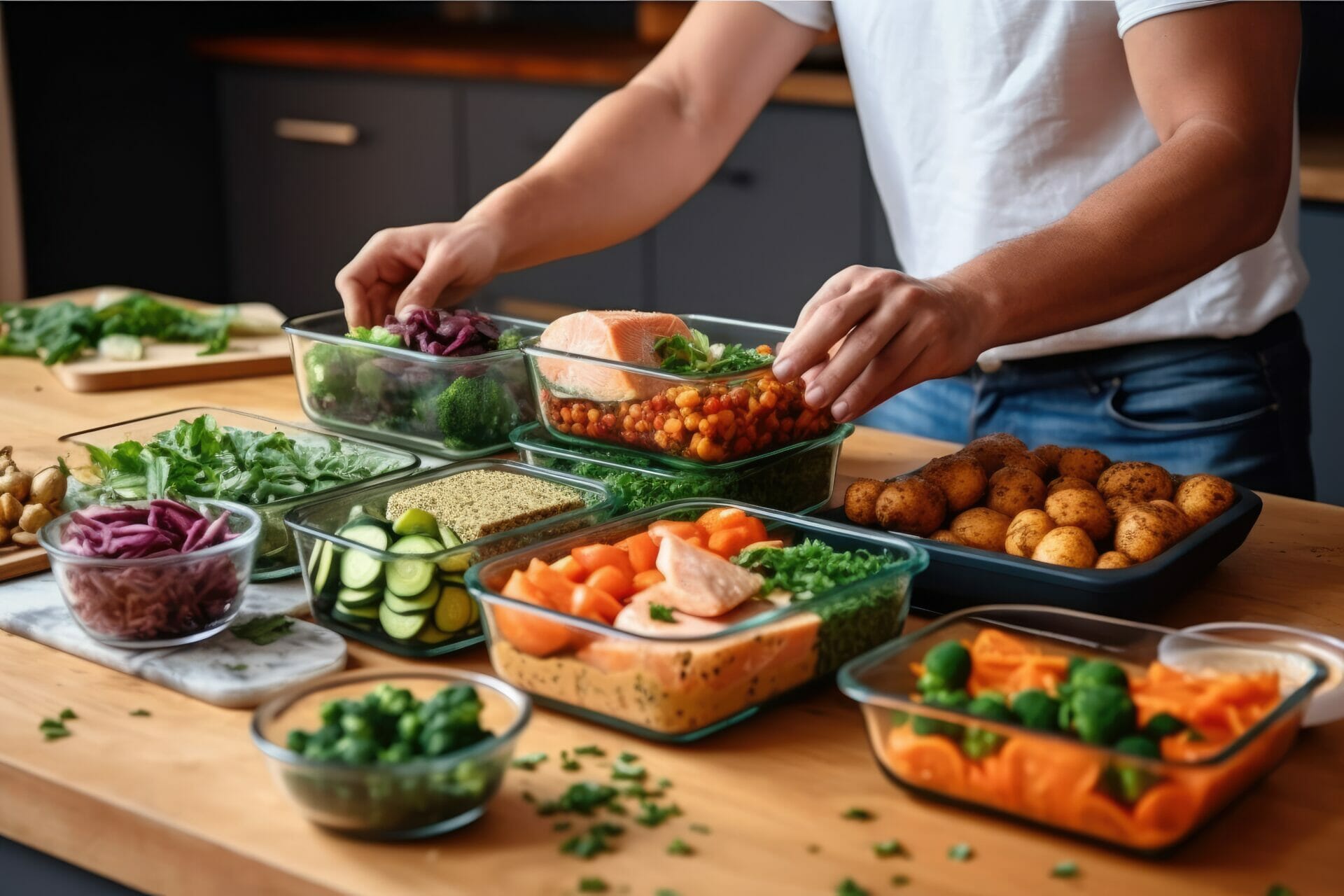Key Takeaways
-
Right nutrition and hydration are important for any liposuction recovery plan to promote cellular regeneration and minimize risks.
-
A properly planned vegan diet contains all of the nutrition necessary to heal — including sufficient protein, healthy fats and antioxidants from whole plant foods.
-
Controlling inflammation with antioxidant superfoods and removing processed items will really make all the difference– in healing and in well-being.
-
Structured planning — like meal prep and portion control — ensures you’re meeting your increased energy and nutrient requirements during recovery.
-
Prioritizing gut health and mindful eating facilitate improved digestion, increased nutrient absorption, and a more holistic recovery.
-
Targeted supplementation with protein, omega-3s, vitamin B12 and vitamin D may be required.
A smart plan fuels recovery, maintains energy, and aids skin elasticity.
Staple foods generally consist of nuts, seeds, beans, greens and whole grains for protein and nutrients. These smart choices reduce inflammation and assist the body in healing.
The gist of the main body is how to craft an easy, satisfying plant-based diet for seamless recuperation.
The Healing Imperative
As a liposuction survivor, what you eat and drink matters. Water and good food assist your body in healing and reducing swelling. A diet full of vitamins, minerals, and sufficient calories fuels cell regeneration and keeps you more robust throughout every phase of healing.
Why Nutrition
Nutrition influences the quality and speed with which you recover from surgery. Key nutrients fuel tissue repair and help keep inflammation at bay. For instance, vitamin C aids in producing collagen, which assists in repairing skin and tissue. The daily target for vitamin C is 75–90 mg.
Protein from beans, lentils and tofu provides your body with the tools it needs to repair wounds. A nutritious diet reduces the complications such as infection or delayed healing. Lean plant proteins, whole grains and a variety of fruits and greens prepare your body with the optimal opportunity to rebound.
Post-liposuction, your energy demands increase, therefore consuming more nourishing foods during this period supports your body in meeting its new requirements.
Vegan Advantage
Plant-based eating has genuine benefits for post-surgical healing. When you load your plate with a rainbow of fruits, vegetables, grains, legumes and nuts, you receive protein and healthy fats even in the absence of animal products.
Beans, quinoa, lentils, chia seeds and walnuts are all great vegan protein and fat sources. These foods are fiber rich, which can help keep digestion smooth during recovery. Antioxidant-rich vegan foods, such as berries and leafy greens, combat swelling and soothe the body’s surgical response.
A vegan diet promotes longevity, as well. It may assist you lose weight and enhance heart health, helping you maintain your recovery.
Inflammation Control
Antioxidant foods keep the swelling down. Blueberries, spinach, and bell peppers are great options to infuse meals with color and power. Eliminating processed snacks and sweets accelerates your body’s healing and reduces the risk of complications post-surgery.
Experiment by incorporating turmeric or flaxseeds into your smoothie or salad to combat swelling and promote healing. Mind your meals to maintain a favorable balance—small, frequent meals can curb the urge to overeat and ease recuperation.
Hydration and Caloric Intake
Water is imperative. Try to get a minimum of eight glasses (approximately 2 liters) daily to aid your body in flushing waste and maintaining healthy skin. Sufficient calories, but not too many, provide your body energy without impeding recovery.
Whole foods, consistent meals, and exercise all contribute to your healing process.
Your Recovery Plan
Eating Plan plant-based recovery after liposuction Establish lucid nutrition objectives with sufficient protein, healthy fats, fiber and water. Pre-plan meals so you don’t fall through the nutritional cracks, and stick with easy routines. Modify your serving sizes and the number of meals to accommodate shifting energy demands.
Smaller meals or snacks every 3–4 hours keeps energy steady and prevents hard hunger swings, which can make recovery easier. Here’s a step-by-step outline:
-
Define daily nutrition goals: protein, fats, carbs, vitamins, and minerals.
-
Pick simple-to-source ingredients and week out your meals.
-
Prep meals in batches to save time and stress.
-
Adjust portion sizes based on hunger and activity level.
-
Consume food every 3-4 hours to facilitate recovery and stable energy.
-
Track water intake and short hydration goals.
-
Recharge when you can, and strive for 7–9 hours of sleep each night.
1. Prioritize Protein
Opt for beans, lentils, tofu, tempeh and quinoa as your source of protein. Add nuts or seeds if you want to pump up your meal with additional plant-based options.
Shoot for at least 1.2–1.6 grams of protein per kilogram of bodyweight during your recovery to aid tissue repair and preserve lean body mass. Just as an example, be sure to pair proteins with vitamin C foods—like bell peppers or citrus—to help your body absorb more iron.
Keeping tabs on your protein with a food app or food journal will help make sure you’re hitting your target, particularly when small, frequent meals are involved.
2. Embrace Fats
Choose avocado, olive oil, nuts, chia and flax for healthy fats. These assist the body’s healing and reduce inflammation.
Concentrate on unsaturated fats, not the saturated or trans kind that can delay healing. So stick with raw nuts or nut butters, and sprinkle seeds into smoothies or salads for effortless, nutrient-packed meals.
Sprinkle in some healthy fats as sauces or dressings – they’ll make your food taste better and help you stay on track.
3. Hydrate Smartly
Consume a minimum of 2 liters (8–10 glasses) of water per day. Herbal teas and fruit-infused water keep the hydration interesting.
Eat some cucumber, oranges, and watermelon to help hydrate, too. Tracking your water intake can help keep you on track. Good hydration keeps your body recovering like magic and prevents energy crashes.
4. Boost Micronutrients
Stir in leafy greens, broccoli, carrots, and red cabbage for a variety of vitamins and minerals.
Add lentils, chickpeas, pumpkin seeds, and citrus for additional iron, zinc, and vitamin C. Eat lots of color(s) of vegetables to hedge your bets.
Keep an eye on micronutrient intake to prevent holes in your comeback.
5. Manage Carbs
Choose whole grains, oats, brown rice and legumes for consistent fuel.
Avoid foods with added sugar or white flour as those WILL make the swelling worse. Include fibrous carbs at every meal to keep digestion flowing.
Essential Nutrients
A balanced plant-based post liposuction recovery plan focuses on the essential nutrients for tissue repair, skin health and immune resilience. For optimal healing, these essentials should be included:
-
Protein (aim for at least 80 grams daily)
-
Vitamin C (500–1,000 mg/day, especially before and after surgery)
-
Iron and zinc
-
Vitamin K
-
Vitamins A and E
-
Healthy fats (omega-3 and omega-6)
-
Water for hydration
-
Antioxidants
-
Complete proteins (quinoa, lentils, beans, tempeh)
-
Nutrient-dense greens (spinach, kale, chard)
Tissue Repair
Tissue repair begins with nutrient dense foods. Berries, lentils, nuts and seeds all promote healing as they’re stuffed with essential nutrients and antioxidants.
Sufficient protein is important for muscle and wound healing. Quinoa is a full plant protein that contains the 9 essential amino acids, and beans and lentils are a good source. Reaching a daily protein goal of 80 grams, for example, ensures the body has all the materials it needs to mend itself.

The pairing of protein and vitamin C (such as black beans and bell peppers) assists your body in utilizing these nutrients more efficiently and enhances recovery. Whole foods contain essential vitamins and minerals. For instance, spinach, kale, and chard provide iron and vitamin K, both essential for blood clotting and tissue health after surgery.
Skin Elasticity
Vitamins A, C and E provide skin health and elasticity. Think carrots, sweet potatoes, citrus fruit and almonds to name a few. These vitamins help the skin bounce back after surgery and minimize visible scarring.
Essential fatty acids found in avocado, nuts, seeds and olive oil nourish your skin from the inside out. They assist the body in utilizing the fat-soluble vitamins, making the diet more effective in healing.
Hydration is crucial for maintaining skin elasticity and cell regeneration. Water is ideal, although herbal teas and water-rich fruits such as cucumber or watermelon are of assistance as well. Make skin-smart food decisions by prioritizing variety, colorful produce and avoiding overly processed fare.
Immune Support
Immunity-boosting is crucial to quick recovery. Citrus fruits, leafy greens, and cruciferous vegetables contain vitamin C and antioxidants which combat infection and reduce swelling.
Zinc and iron, found in beans, lentils, pumpkin seeds and leafy greens, bolster immune function and healing. A varied diet covers all the body’s bases.
Mix up different fruits, vegetables, grains, and legumes for a wide spectrum of nutrients. Keeping a log or nutrition app to track intake and ensure you’re meeting recovery goals.
Holistic Healing
Holistic healing is about more than just the body’s recovery post-liposuction. It spans nutrition, movement, and mindfulness, all synergizing to heal the body. For the vegans out there, it’s this mix of plants, light movement, and mindful practices that nourish body and mind.
Gut health, hydration, sleep, and self-image count here, as all of these factors contribute to a seamless recovery.
Gut Health
Your healthy gut is key for healing. Probiotic-rich foods like kimchi, sauerkraut, and unsweetened plant-based yogurt balance the gut microbiome. Fermented foods are good as they provide live bacteria which assist digestion and can increase your immune system.
Sprinkle in prebiotic foods—garlic, onions, leeks, bananas—that feed the good bacteria. This keeps digestion regular and aids the body to absorb more nutrients from food. High-fiber options such as whole grains, beans, and leafy greens help keep things moving and ensure the body receives what it requires.
It does a good job of checking in on gut health during recovery. When digestion, bloatedness or discomfort changes, it can signal it’s time to tweak fiber or experiment with other fermented foods. Everyone’s gut responds a touch differently, so some trial and error might be required.
Mindful Eating
Mindful eating is about being conscious of your eating habits. Eat more slowly, chew well, and pay attention to taste – these can help your body feel full and enhance digestion. It helps individuals identify genuine hunger signals and prevent gluttony.
Dining in a serene environment, without many distractions, can enhance the enjoyment of meals. It reduces stress – which can occasionally impact food decisions. Checking in with yourself before and after eating helps make sure meals align with recovery goals and energy needs.
Gentle Movement
Light activity is safe and beneficial post-liposuction. Light walks, light stretching or beginner yoga promote circulation and can reduce inflammation. These activities promote joint health and mood, both essential during healing.
Trust your body and remain gentle with movement. If it feels wrong, back off. In the long run, this mild activity increases flexibility and energizes you — smoothing your experience of daily life.
Sleep and Hydration
Good sleep is essential for the body to heal. Aim for sufficient sleep each night, because most healing occurs while you sleep.
We’ve all heard that we should consume at least eight glasses of water, and for good reason – it keeps the body hydrated and flushes out waste – supporting all stages of recovery.
Strategic Supplementation
Post-liposuction, recovery on a plant-based diet CAN be seamless when you backfill with strategic supplements. A lot of us obtain the majority of our daily nutrients from whole foods, such as fruits and vegetables; however, recuperation might require a bit extra.
Strategic supplementation aids your body in rebuilding and healing, particularly when some nutrients are more difficult to source from a vegan diet. With the right plan, you can fuel your energy, repair your tissues, and bounce back sooner.
-
Protein supplements are sometimes required post-surgery. Muscle recovery and tissue repair require sufficient protein. Plant-based diets fill this with beans, lentils, tofu, tempeh, and quinoa, but immediately post-surgery your appetite might be low.
Pea, hemp, or brown rice protein powders can assist you in hitting the 20–30 gram target per meal. Other folks tend to find shakes easier than big meals while healing.
-
Omega-3s aid your body combat swelling and repair cells. Vegans obtain plant-based omega-3s from flaxseed, chia seeds, walnuts, or algae oil. As these sources might not provide sufficient amounts of EPA and DHA, algae-based omega-3 supplements are an excellent choice.
They plug a typical vegan hole and aid your skin and tissues in repairing.
-
Vitamin B12 is not present in plant foods in an active form. B12 keeps your nerves and blood healthy and helps your body make DNA. Post-surgery, your requirements can increase, so daily B12 supplements are essential.
Opt for methylcobalamin or cyanocobalamin forms.
-
Vitamin D is crucial to both bone and immune health. Sunlight sets off your body to produce vitamin D, but most of us, particularly those in cloudy climates, require additional amounts.
Vegan D2 or D3 from lichen will get you to healthy levels. This is crucial for tissue repair and maintaining your immunity after surgery.
Monitor your supplement intake. Too much of some vitamins can cause harm, while too little slows healing. Track your meals, read labels, and ask a healthcare provider to check your blood levels if unsure.
Supplements should add to your plant-based diet, not replace whole foods. Eating at least five servings of fresh fruits and vegetables each day still covers most needs. For hydration, experts suggest at least eight glasses of water per day, but you may need more if you live in a warm place or move a lot.
Foods like cucumbers, melons, and oranges add water to your diet.
Examine the impact of supplements on your recovery. Expect reduced inflammation, increased energy, and consistent recovery. Make adjustments and stay whole food based.
A Sample Meal Plan
A solid meal plan can help vegans bounce back from liposuction by providing the body with what it needs to heal, while keeping meals light and digestible. For most of us, a plan is fewer decisions to make during the day and less chance of reaching for the nutritional junk drawer, particularly when we’re slammed.
It adds organization and accountability to your eating—using a food diary simplifies this step. The sample meal plan below includes nutrient-dense foods, simple recipes, and a variety of flavors and colors to hit the nutritional trifecta. It’s intended as a guide, not gospel, so don’t hesitate to switch in like foods or slide meals around to accommodate your schedule.
|
Time |
Meal/Snack |
Foods Included |
Key Nutrients |
Prep Notes |
|---|---|---|---|---|
|
07:30 |
Breakfast |
Oatmeal with chia seeds, blueberries, almond milk, walnuts |
Fiber, omega-3s, protein |
5 min prep; easy to digest |
|
10:00 |
Snack |
Sliced apple with peanut butter |
Healthy fats, protein |
Quick, no cook |
|
12:30 |
Lunch |
Quinoa salad with chickpeas, cherry tomatoes, kale, olive oil, lemon juice |
Protein, iron, vitamins A/C |
Prep ahead; vibrant colors |
|
15:30 |
Snack |
Carrot sticks, hummus |
Vitamin A, plant protein |
Keeps well in fridge |
|
18:30 |
Dinner |
Lentil stew with sweet potatoes, Brussels sprouts, carrots, spices |
Protein, fiber, minerals |
One-pot, batch cook |
|
20:00 |
Evening Snack |
Greek-style soy yogurt with flaxseeds and kiwi |
Calcium, omega-3s, vitamin C |
2 min prep |
A combination of deeply colored vegetables, whole grains, and plant-based proteins keeps meals balanced and packed with vitamins and minerals. Take kale and Brussels sprouts, for instance, which provide vitamin K, or sweet potatoes and carrots that are great sources of beta-carotene.
Ensuring you have sources of plant-based omega-3s, like walnuts and flaxseeds, is crucial as omega-3s can help reduce inflammation and promote healing. It provides protein from beans, chickpeas, soy yogurt, and nuts, all of which are easy on the stomach and easy to stir into one-pot meals or toss in salads.
These are easy to prepare ahead of time—a couple hours on a weekend can go a long way during the week. Meal prepping can introduce order to a week, when time is scarce. Sunday afternoons blocked off for meal prep can assist with this.
One-pot wonders like lentil stew are versatile and time saving. Giving days themes, such as “Salad Bowl Monday” or “Soup Night Thursday,” can maintain the plan’s interest without unnecessarily complicating it.
Monitoring meals with a food diary may help identify nutrition gaps and maintain recovery momentum. This plan is a template–mix in other grains, throw in tofu, experiment with different nuts and seeds to customize to your taste and local food options.
Conclusion
Being vegan after liposuction just feels right for body and mind. Fueling your body with whole foods, plenty of fresh produce, healthy fats and sufficient protein aids wound healing and provides sustained energy. Easy substitutions—such as lentils, nuts or tofu—can slot seamlessly into everyday dishes. Little changes, such as drinking more water or adding seeds for crunch, accumulate with time. Every meal is an opportunity to nurture your body with what it requires to mend. For those wanting to maintain recovery slick and simple, plant-based nutrition offers real assistance. Got questions or want to share your recovery tips? Leave a comment or get in touch—let’s continue the dialogue and support each other in looking and feeling our very best!
Frequently Asked Questions
Can vegans follow a proper recovery nutrition plan after liposuction?
Yes. All the key ingredients for healing can come from plants. Complete plant‑based recovery nutrition plan liposuction for vegans: the protein, vitamins, minerals and hydration of recovery.
What plant-based foods help with post-liposuction healing?
Foods high in protein, vitamin C, zinc and antioxidants are beneficial. Think lentils, tofu, nuts and seeds, whole grains, leafy greens, and berries.
Are supplements needed for vegan recovery after liposuction?
Supplements can be beneficial, particularly with vitamin B12, vitamin D and omega-3s. Check with your healthcare provider for guidance.
How much water should vegans drink during recovery?
Shoot for a minimum of 2 liters of water per day, unless your doctor says otherwise. Staying adequately hydrated supports healing and reduces swelling.
Can a vegan diet reduce inflammation after surgery?
Yes. Fruits, vegetables and whole grains are highly anti-inflammatory, which is great because it can help reduce swelling and recovery time!
Is protein intake important for vegan liposuction recovery?
Protein is important for tissue repair. Incorporate beans, lentils, tofu, tempeh and quinoa in your meals to satisfy your protein requirements.
How soon can vegans return to normal eating after liposuction?
Most are able to return to normal meals within a day or two after surgery. Concentrate on healing with simple, nutrient-packed cuisine. Ask your doctor.





